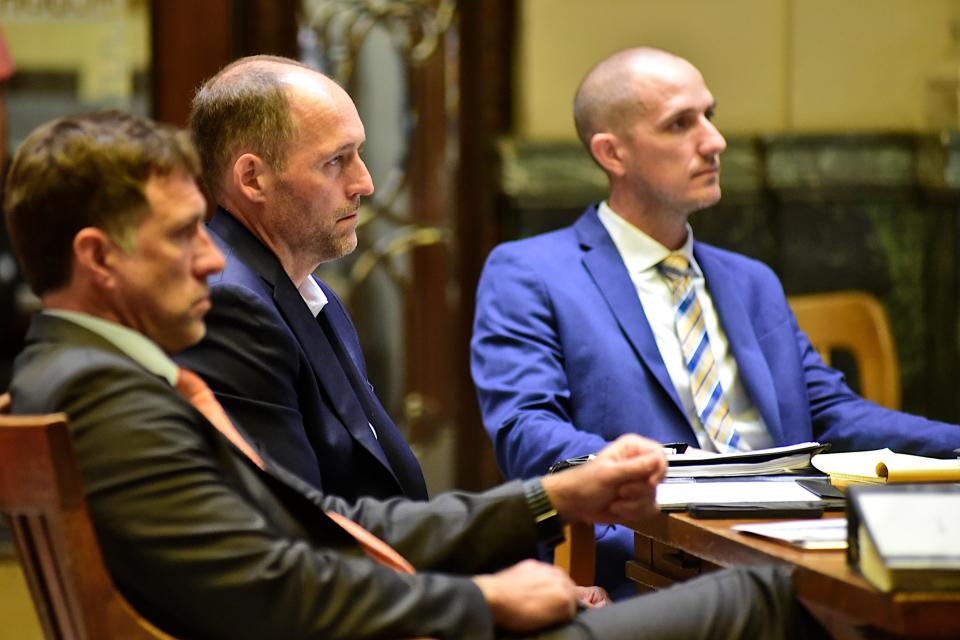'He still would have died': Coroner testifies Cassaro's injuries were fatal if not lengthy
Sean Cassaro's neck wounds lead to his death, but the forensic pathologist who analyzed them determined they did not prove the man suffered a prolonged attack.
Jeffrey Hudson, a Lucas County deputy coroner, testified Wednesday in Crawford County Common Pleas Court during the trial of Bucyrus resident Thomas Brown, 50, who faces two counts of murder in Cassaro's death.
Hudson's autopsy report concluded Cassaro's cause of death was manual strangulation.
Those findings brought a lot of questions from the state's special prosecutors, Micah Ault and Drew Wood, as well as Brown's defense attorneys, James Mayer III and Sean Boone.

'Several findings that were consistent with strangulation'
Hudson explained to jurors he has performed nearly 4,000 autopsies throughout his career. He said results are more accurate the sooner he can examine a body.
Cassaro died shortly after 3 a.m. Jan. 22, 2023, a Sunday. Hudson said the man's body was waiting for him when he arrived at work 8 a.m. the next day. He said approximately 30 hours was soon enough to ensure accuracy.
"An autopsy is broken into two main sections," Hudson said.
First is the external analysis of the deceased person. Next comes the internal examination of every organ.
Coroners take extensive photos throughout the process. Attorneys showed some of Hudson's autopsy photos to jurors Wednesday so they could understand what the coroner was telling them.
"We had several findings that were consistent with strangulation," Hudson said.
The coroner showed jurors an indented pattern in the skin around Cassaro's neck, which he said were lingering recesses from the pressure applied 30 hours earlier.
Cassaro's injuries indicate he died of blood strangulation
The rest of Cassaro's neck wounds were internal.
Judge Sean Leuthold warned jurors the dialogue about those injuries would be gruesome, and even paused attorneys on two occasions to give family members a chance to leave if they wanted to avoid seeing images from Cassaro's autopsy. Everyone stayed.

Wood eventually showed the jury a picture of an exposed muscle within Cassaro's neck, which the coroner explained was colored a deeper red than normal because of hemorrhaging.
Wood next displayed an image of Cassaro's thyroid, and Hudson pointed out where the gland's cartilage had been fractured.
The man's other afflictions included congestion in his face and brain, as well as burst capillaries in his eyes, all of which, the coroner said, indicated blood strangulation.
'He still would have died from the strangulation'
Hudson clarified for jurors that strangulation does not always mean a person's airway is compressed. Blood strangulation, he said, occurs when airways remain untouched, but arteries or veins are squeezed.
When forces around a person's neck compress a vein, blood attempting to leave the brain will build up. As that pressure increases, eye capillaries burst, a condition known as petechia. The longer the vein is compressed, the more petechia Hudson said he would expect to find during the autopsy.
Other times, though, a person's neck is squeezed so hard that return veins as well as supply arteries are blocked, which prevents blood from entering the brain. Since no new blood can enter the head, the pressure will not increase. Hudson said those instances of blood strangulation typically do not result in petechia of the eye capillaries.
Boone asked the coroner if Cassaro's injuries offered any insight into how long the man's neck may have been squeezed. Hudson answered the severity of both Cassaro's neck hemorrhages and his thyroid fracture were a product of intensity, not time.
The immediacy of the death would be hard to predict, Hudson said, since every person's body reacts differently to trauma. Cassaro may have tried to stand up, but the effort would not have lasted long.
"He still would have died from the strangulation," Hudson said. "Even if it was later in time, he still would have died."
Brown's trial is scheduled to resume with more prosecution witnesses Thursday morning.
ztuggle@gannett.com
419-564-3508
This article originally appeared on Bucyrus Telegraph-Forum: Coroner testifies about Sean Cassaro's injuries in Thomas Brown trial

